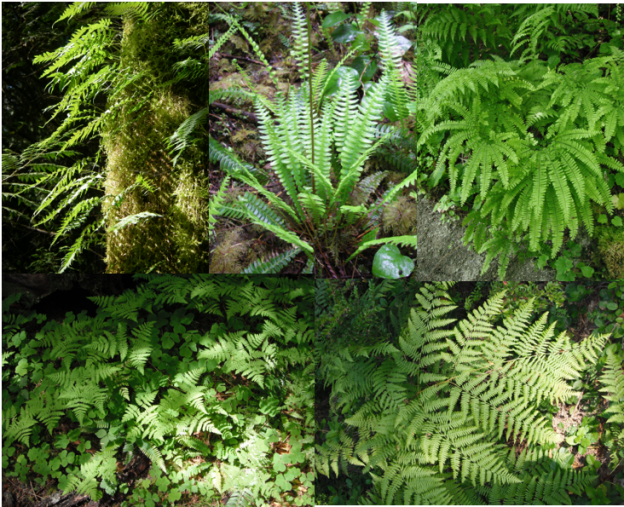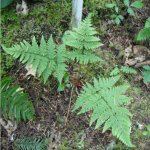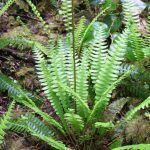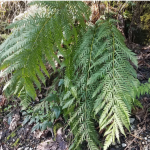Ferns in photo: Top, Left to Right: Licorice Fern, Deer Fern, Maidenhair Fern; Bottom: Oak Fern, and Bracken Fern.
Scroll to the bottom of the page for links to individual species!
Ferns Division Pteridophyta
Ferns date back to the beginning of the Carboniferous period (360 million years ago) and are relatively abundant in the fossil record. They are a diverse group, ranging from tiny aquatic plants, such as our Pacific Mosquitofern, Azolla filiculoides, to large tree ferns, Cyathea sp., which may reach more than 72 feet (24m) high and have fronds 15 feet (5m) or more in length. Tree ferns were more common during the time of the dinosaurs. Today they have a more limited distribution in tropical or subtropical regions and the temperate rainforests of Australia and New Zealand.
Ferns are like flowering plants in that they have true leaves and a vascular system to transport water and nutrients. But they do not produce seeds. Instead, they have a complex life cycle consisting of two alternate generations. The diploid sporophyte generation is the one we recognize as a fern. Ferns produce spores on the undersides of their fronds, which after they are released and fall to an amenable substrate, will grow into moss-like plants (prothallia). These haploid gametophytes are free-living organisms. They in turn produce gametes (sperm and eggs). A mobile, flagellate sperm seeks out an egg to fertilize. The presence of water during this stage is critical and is why most ferns need to live in a moist climate. Once an egg is fertilized, it will grow into what we recognize as a fern.
Much of the terminology used to describe ferns comes from their similarity in appearance to bird feathers. In botany, pinnae are the leaflets of the pinnately compound leaf, whereas in zoology pinnae are feathers. Pinnate leaves are those that have leaflets arranged along a stem, making it long like a feather; in contrast to palmately compound leaves where all the leaflets arise at one point like some palm leaves, spread out like the palm of your hand.
In the Landscape: Many Ferns are useful in the landscape as accent plants. Although most are at home in a moist woodland garden, some will withstand some drought and are good choices for a rock garden. A few oddballs find their niches being either epiphytic on trees or entirely aquatic.
Propagation of Ferns: Examine the underside of fern fronds for the presence of spore cases. Use a magnifying glass to make sure that spores are ripe and not already dispersed. Place fronds with spores in a manila envelope and dry for a week at 70º F (21º C). Scatter the dust-like spores on a moist soil mixture (2/3 peat moss or coconut fiber & 1/3 perlite). Cover with clear glass or plastic, leaving an inch or so of space. Keep moist at 65-75º F (18-24º C). Spores germinate and produce moss-like prothallia. The prothallia in turn produce gametes–Fertilization occurs in 3-6 months. Once the tiny sporophyte ferns begin to grow, they may be pricked out and transplanted.
Depending on the species of fern, several vegetative propagation methods are also possible. Rhizomes may be divided. Some species produce small “bulblets” or vegetative buds that may be detached to form new plants.
Use by People: Natives sometimes ate the fiddleheads (the uncurling new growth of fronds) or rhizomes of ferns. Most, however, were considered famine food.
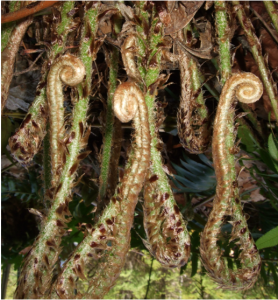
Sword Fern Fiddleheads.
Fiddleheads: Ostrich Fern fiddleheads are considered the best for edibility; they are more common on the east coast and are only found in BC in our region. Bracken Fern fiddleheads were eaten by some natives but are now known to be poisonous to livestock & are considered carcinogenic. Lady Fern fiddleheads were also sometimes eaten by natives. Boiling or steaming fiddleheads is thought to help remove or break down toxic enzymes.
Rhizomes: Spreading Wood Fern appears to have been the favorite fern rhizome eaten by natives. Lady Fern rhizomes may have been eaten as well although it may have been confused with Wood Fern. Many tribes ate the plentiful Bracken Fern rhizomes, but again, caution should be taken due to toxicity & carcinogenic concerns. Sword Fern rhizomes were considered a starvation food. Rhizomes were usually steamed or baked in a pit overnight or were roasted over an open fire.
Licorce Fern is a well known medicinal herb used for coughs & sore throats. It is also used for flavoring.
Ferns were often used by natives for lining or covering food storage baskets or cooking vessels.
Wildlife Value: Ferns have very little value for wildlife. Fronds are occasionally browsed by deer, hare or grouse. Fronds may be used as nesting material by rodents or in dens of larger animals.
Ferns are classified into several different families:
The Wood Fern Family–Dryopteridaceae
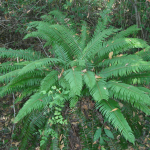 Western Sword Fern, Polystichum munitum and other Polystichums
Western Sword Fern, Polystichum munitum and other Polystichums
.
.
.
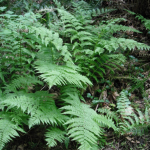 Lady Fern, Athyrium felix-femina
Lady Fern, Athyrium felix-femina
.
.
.
Spreading Wood Fern, Dryopteris expansa
.
.
.
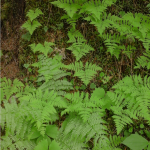 Pacific Oak Fern, Gymnocarpium disjunctum
Pacific Oak Fern, Gymnocarpium disjunctum
.
.
.
USDA: The Wood Fern Family—Dryopteridaceae
Newer classification: The Sensitive Fern Family—Onocleaceae
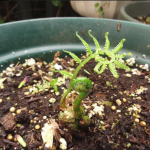 Ostrich Fern, Matteuccia struthiopteris
Ostrich Fern, Matteuccia struthiopteris
.
.
.
Chain Fern family–Blechnaceae
.
.
.
Giant Chain Fern, Woodwardia fimbriata
.
.
.
.
Maidenhair Fern family—Pteridaceae
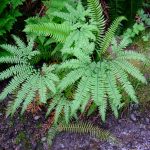 Western Maidenhair Fern, Adiantum aleuticum
Western Maidenhair Fern, Adiantum aleuticum
.
.
.
American Parsley Fern, Cryptogramma acrostichoides
Spleenwort family–Aspleniaceae
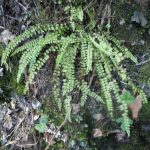 Maidenhair Spleenwort, Asplenium trichomanes
Maidenhair Spleenwort, Asplenium trichomanes
.
.
.
Marsh Fern family–Thelypteridaceae
Narrow Beech Fern, Phegopteris connectilis
Bracken Fern family–Dennstaedtiaceae
Bracken Fern, Pteridium aquilinum
Polypody family–Polypodiaceae
Licorice Fern, Polypodium glycyrrhiza
Leathery Polypody, Polypodium scouleri
Azolla family–Azollaceae
Pacific mosquitofern Azolla filiculoides

